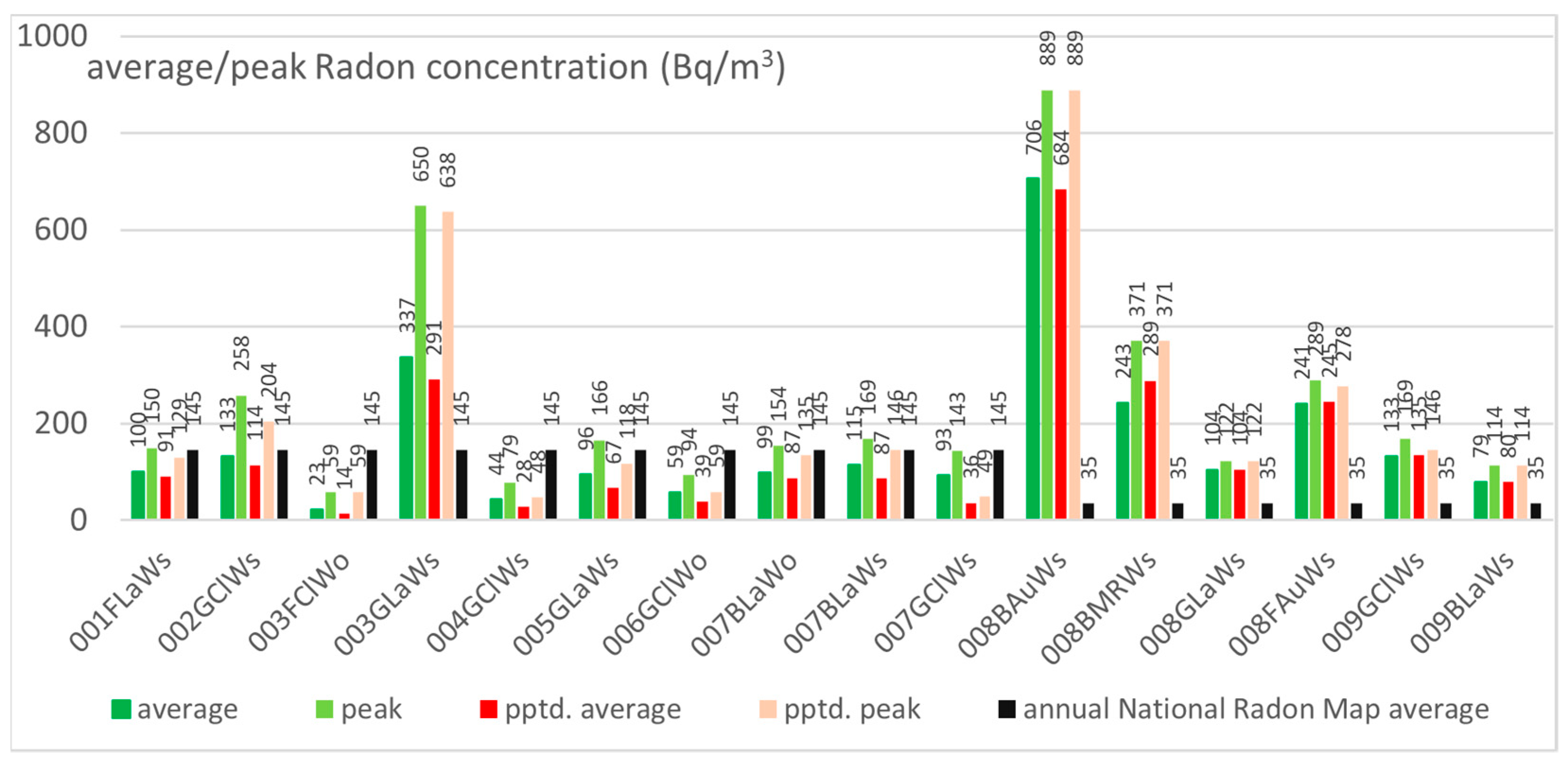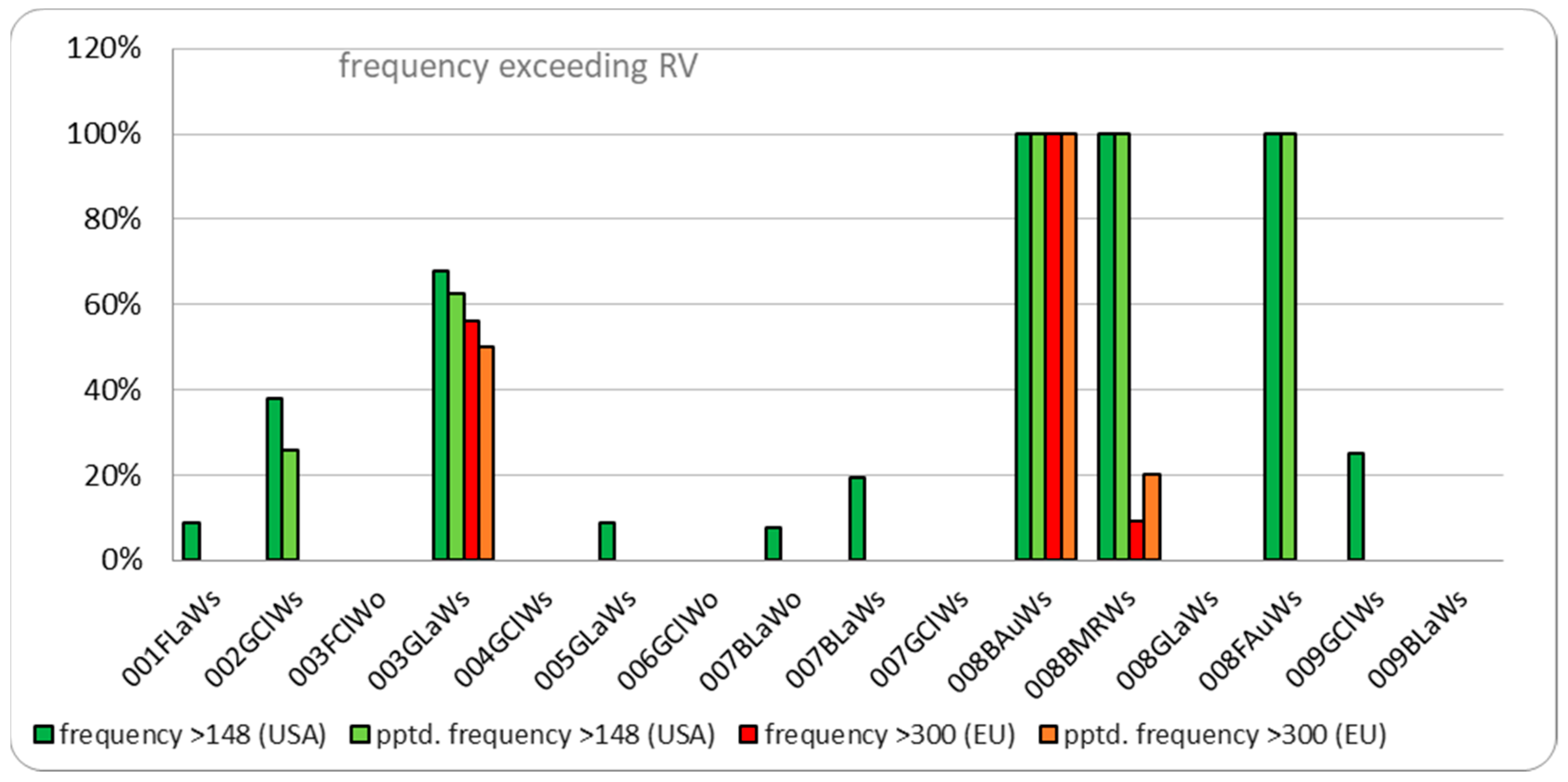S.Ind.Ai.R.—School Network for Indoor Air Quality and Radon: An Innovative Platform for the Flexible Development of Indoor Environment Research Projects in Greek Schools †
Abstract
:1. Introduction
2. SINDAIR: An Innovative School Network for Health Awareness and Research
3. Materials and Methods
4. Preliminary Radon Results
5. Discussion
6. Conclusions
Author Contributions
Funding
Institutional Review Board Statement
Informed Consent Statement
Data Availability Statement
Acknowledgments
Conflicts of Interest
References
- Chatzidiakou, L.; Mumovic, D.; Summerfield, A.J. What Do We Know about Indoor Air Quality in School Classrooms? A Critical Review of the Literature. Intell. Build. Int. 2012, 4, 228–259. [Google Scholar] [CrossRef]
- Kelly, F.J.; Fussell, J.C. Improving Indoor Air Quality, Health and Performance within Environments Where People Live, Travel, Learn and Work. Atmos. Environ. 2019, 200, 90–109. [Google Scholar] [CrossRef]
- Kakoulli, C.; Kyriacou, A.; Michaelides, M.P. A Review of Field Measurement Studies on Thermal Comfort, Indoor Air Quality and Virus Risk. Atmosphere 2022, 13, 191. [Google Scholar] [CrossRef]
- Wargocki, P.; Wyon, D.P. The Effects of Moderately Raised Classroom Temperatures and Classroom Ventilation Rate on the Performance of Schoolwork by Children (RP-1257). HvacR Res. 2007, 13, 193–220. [Google Scholar] [CrossRef]
- Coley, D.A.; Greeves, R.; Saxby, B.K. The Effect of Low Ventilation Rates on the Cognitive Function of a Primary School Class. Int. J. Vent. 2007, 6, 107–112. [Google Scholar] [CrossRef]
- Kalimeri, K.K.; Saraga, D.E.; Lazaridis, V.D.; Legkas, N.A.; Missia, D.A.; Tolis, E.I.; Bartzis, J.G. Indoor Air Quality Investigation of the School Environment and Estimated Health Risks: Two-Season Measurements in Primary Schools in Kozani, Greece. Atmos. Pollut. Res. 2016, 7, 1128–1142. [Google Scholar] [CrossRef]
- Synnefa, A.; Polichronaki, E.; Papagiannopoulou, E.; Santamouris, M.; Mihalakakou, G.; Doukas, P.; Siskos, P.A.; Bakeas, E.; Dremetsika, A.; Geranios, A.; et al. International Journal of Ventilation An Experimental Investigation of the Indoor Air Quality in Fifteen School Buildings in Athens, Greece An Experimental Investigation of the Indoor Air Quality in Fifteen School Buildings in Athens, Greece. Int. J. Vent. 2003, 2, 185–201. [Google Scholar] [CrossRef]
- World Health Organization. WHO Handbook on Indoor Radon: A Public Health Perspective; World Health Organization: Geneva, Switzerland, 2009; ISBN 978-92-4-154767-3. [Google Scholar]
- Appleton, J.D. Radon in Air and Water. In Essentials of Medical Geology: Revised Edition; Selinus, O., Ed.; Springer: Dordrecht, The Netherlands, 2013; pp. 239–277. ISBN 978-94-007-4375-5. [Google Scholar]
- Riudavets, M.; Garcia de Herreros, M.; Besse, B.; Mezquita, L. Radon and Lung Cancer: Current Trends and Future Perspectives. Cancers 2022, 14, 3142. [Google Scholar] [CrossRef]
- Nunes, L.J.R.; Curado, A.; Da Graça, L.C.C.; Soares, S.; Lopes, S.I. Impacts of Indoor Radon on Health: A Comprehensive Review on Causes, Assessment and Remediation Strategies. Int. J. Environ. Res. Public Health 2022, 19, 3929. [Google Scholar] [CrossRef]
- Zoran, M.A.; Savastru, R.S.; Savastru, D.M.; Tautan, M.N. Impacts of Exposure to Air Pollution, Radon and Climate Drivers on the COVID-19 Pandemic in Bucharest, Romania: A Time Series Study. Environ. Res. 2022, 212, 113437. [Google Scholar] [CrossRef]
- Madas, B.G.; Boei, J.; Fenske, N.; Hofmann, W.; Mezquita, L. Effects of Spatial Variation in Dose Delivery: What Can We Learn from Radon-Related Lung Cancer Studies? Radiat. Environ. Biophys. 2022, 61, 561–577. [Google Scholar] [CrossRef] [PubMed]
- Maier, A.; Wiedemann, J.; Rapp, F.; Papenfuß, F.; Rödel, F.; Hehlgans, S.; Gaipl, U.S.; Kraft, G.; Fournier, C.; Frey, B. Radon Exposure—Therapeutic Effect and Cancer Risk. Int. J. Mol. Sci. 2020, 22, 316. [Google Scholar] [CrossRef] [PubMed]
- Palmer, J.D.; Prasad, R.N.; Cioffi, G.; Kruchtko, C.; Zaorsky, N.G.; Trifiletti, D.M.; Gondi, V.; Brown, P.D.; Perlow, H.K.; Mishra, M.V.; et al. Exposure to Radon and Heavy Particulate Pollution and Incidence of Brain Tumors. Neuro-Oncology 2023, 25, 407–417. [Google Scholar] [CrossRef]
- Lu, L.; Zhang, Y.; Chen, C.; Field, R.W.; Kahe, K. Abstract P664: Radon Exposure and Cerebrovascular Disease-A Systematic Review and Meta-Analysis of Observational Studies in Occupational and General Populations. Stroke 2021, 52, AP664. [Google Scholar] [CrossRef]
- Besis, A.; Avgenikou, A.; Pantelaki, I.; Serafeim, E.; Georgiadou, E.; Voutsa, D.; Samara, C. Hazardous Organic Pollutants in Indoor Dust from Elementary Schools and Kindergartens in Greece: Implications for Children’s Health. Chemosphere 2023, 310, 136750. [Google Scholar] [CrossRef] [PubMed]
- Bing, S. CR-39 Radon Detector. Nucl. Tracks Radiat. Meas. 1993, 22, 451–454. [Google Scholar] [CrossRef]
- Elío, J.; Petermann, E.; Bossew, P.; Janik, M. Machine Learning in Environmental Radon Science. Appl. Radiat. Isot. 2023, 194, 110684. [Google Scholar] [CrossRef]
- Clouvas, A.; Xanthos, S.; Takoudis, G. Indoor Radon Levels in Greek Schools. J. Environ. Radioact. 2011, 102, 881–885. [Google Scholar] [CrossRef]
- Marsh, J.W.; Tomášek, L.; Laurier, D.; Harrison, J.D. Effective dose coefficients for radon and progeny: A review of icrp and unscear values. Radiat. Prot. Dosim. 2021, 195, 1–20. [Google Scholar] [CrossRef]
- Curguz, Z.; Venoso, G.; Zunic, Z.S.; Mirjanic, D.; Ampollini, M.; Carpentieri, C.; Di Carlo, C.; Caprio, M.; Alavantic, D.; Kolarz, P. Spatial Variability of Indoor Radon Concentration in Schools: Implications on Radon Measurement Protocols. Radiat. Prot. Dosim. 2020, 191, 133–137. [Google Scholar] [CrossRef]
- Loffredo, F.; Opoku-Ntim, I.; Meo, G.; Quarto, M. Indoor Radon Monitoring in Kindergarten and Primary Schools in South Italy. Atmosphere 2022, 13, 478. [Google Scholar] [CrossRef]
- Nikolopoulos, D.; Kottou, S.; Louizi, A.; Petraki, E.; Vogiannis, E.; Yannakopoulos, P. Factors Affecting Indoor Radon Concentrations of Greek Dwellings through Multivariate Statistics-First Approach. J. Phys. Chem. Biophys. 2014, 4, 2161-0398. [Google Scholar] [CrossRef]
- Baltrėnas, P.; Grubliauskas, R.; Danila, V. Seasonal Variation of Indoor Radon Concentration Levels in Different Premises of a University Building. Sustainability 2020, 12, 6174. [Google Scholar] [CrossRef]
- Seftelis, I.; Nicolaou, G.; Trassanidis, S.; Tsagas, F.N. Diurnal Variation of Radon Progeny. J. Environ. Radioact. 2007, 97, 116–123. [Google Scholar] [CrossRef] [PubMed]
- Sá, J.P.; Branco, P.T.; Alvim-Ferraz, M.C.; Martins, F.G.; Sousa, S.I. Radon in Indoor Air: Towards Continuous Monitoring. Sustainability 2022, 14, 1529. [Google Scholar] [CrossRef]
- Tokonami, S. Why Is 220Rn (Thoron) Measurement Important? Radiat. Prot. Dosimetry 2010, 141, 335–339. [Google Scholar] [CrossRef]
- Kendall, G.M.; Smith, T.J. Doses from Radon and Its Decay Products to Children. J. Radiol. Prot. 2005, 25, 241. [Google Scholar] [CrossRef]




Disclaimer/Publisher’s Note: The statements, opinions and data contained in all publications are solely those of the individual author(s) and contributor(s) and not of MDPI and/or the editor(s). MDPI and/or the editor(s) disclaim responsibility for any injury to people or property resulting from any ideas, methods, instructions or products referred to in the content. |
© 2023 by the authors. Licensee MDPI, Basel, Switzerland. This article is an open access article distributed under the terms and conditions of the Creative Commons Attribution (CC BY) license (https://creativecommons.org/licenses/by/4.0/).
Share and Cite
Batris, E.; Georgaki, E.; Nikolopoulos, D.; Valais, I.; Moustris, K. S.Ind.Ai.R.—School Network for Indoor Air Quality and Radon: An Innovative Platform for the Flexible Development of Indoor Environment Research Projects in Greek Schools. Environ. Sci. Proc. 2023, 26, 80. https://doi.org/10.3390/environsciproc2023026080
Batris E, Georgaki E, Nikolopoulos D, Valais I, Moustris K. S.Ind.Ai.R.—School Network for Indoor Air Quality and Radon: An Innovative Platform for the Flexible Development of Indoor Environment Research Projects in Greek Schools. Environmental Sciences Proceedings. 2023; 26(1):80. https://doi.org/10.3390/environsciproc2023026080
Chicago/Turabian StyleBatris, Evangelos, Evangelia Georgaki, Dimitrios Nikolopoulos, Ioannis Valais, and Konstantinos Moustris. 2023. "S.Ind.Ai.R.—School Network for Indoor Air Quality and Radon: An Innovative Platform for the Flexible Development of Indoor Environment Research Projects in Greek Schools" Environmental Sciences Proceedings 26, no. 1: 80. https://doi.org/10.3390/environsciproc2023026080
APA StyleBatris, E., Georgaki, E., Nikolopoulos, D., Valais, I., & Moustris, K. (2023). S.Ind.Ai.R.—School Network for Indoor Air Quality and Radon: An Innovative Platform for the Flexible Development of Indoor Environment Research Projects in Greek Schools. Environmental Sciences Proceedings, 26(1), 80. https://doi.org/10.3390/environsciproc2023026080








